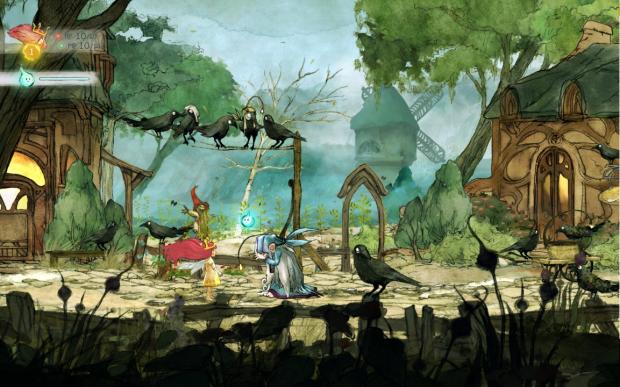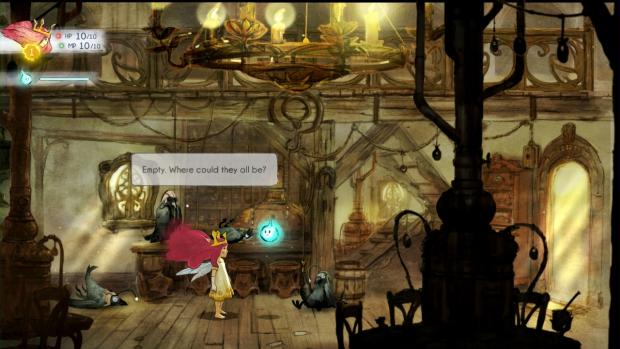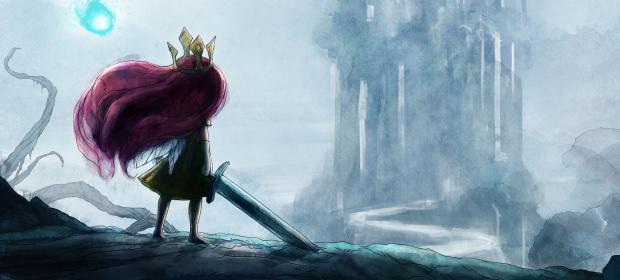One of the nicest surprises to arise from the European Game Developers Conference this year was that of the new game coming from the lead designer and lead writer of Far Cry 3. Indeed, the new title that Patrick Plourde and Jeffrey Yohalem have been working on came as a somewhat big shift in direction after last year’s jungle-based shooter.
You can read our interview with Jeffrey Yohalem, here.
Child of Light was pitched as an interactive poem, and it really does seem just that. The whole game plays out in rhyme, with all of the characters who inhabit the game world speaking in a strangely poetic manner. If that wasn’t an interesting enough starting point, the game is also somewhat of an homage to Japanese Role-Playing Games, and the early Final Fantasy titles in particular. And all of that is wrapped up in a lovely UbiArt-designed package.
As soon as our hands-on time with the game at Ubisoft Digital Days begins, you can tell that this game is going to be different. The premise is that players take on the role of Aurora – a young girl who appears as a Princess in a magical land. We are told however that all is not what it seems, and – not to reveal any spoilers – there is a dark side to the story, where the lines between reality and dreams are blurred. Aurora is joined on her quest by Igniculus, a Firefly who helps guide her along her way, providing assistance when he can.
The game plays as a side-scrolling RPG, with large portions of the game spent exploring the mysterious area that we find ourselves in. The player can interact with other characters, solve some basic puzzles and buy supplies – a lot of your typical role-playing fare. And in good Final Fantasy traditions, when the player does encounter an enemy that they need to get past, the game will quickly switch to a turn-based combat system.
This system will be pretty familiar to RPG veterans, and players can attack, defend, cast spells or use items, all of which they do whilst taking turns with their enemies. There are two interesting points to mention here: firstly the interrupt bar. At the bottom of the screen is a bar, showing when each character will attack, in turn, headed by a “casting” zone. The theory here is that if you connect with an attack whilst your enemy is also in the casting zone, you will interrupt their attack and they lose their turn. This brings an element of strategy to choosing when to defend and when to employ either fast or charged attacks. Enemies also each have a weakness, so a clever use of the correct spells or attacks will give you a further edge in battle.

The other in-battle feature is linked to the fact that Igniculus can actually be controlled by a second player at any point in the game. In normal gameplay, he can light the way in dark areas, collect hard-to-reach collectibles and even help solve puzzles (in single player you can switch between controlling Aurora and Igniculus when you wish). But in battle modes, if a second player is controlling the Firefly, they can collect bonus health and MP orbs, and also use his light to blind enemies – hampering them and delaying their attacks. These two system of interrupting and delaying enemies can be wisely combined to really hammer your opponents hard.
You even have have elements such as levelling up your characters – and your party of heroes as it grows throughout the game – augmenting powers and improving your skills as you go along. But interestingly, whilst the game maintains many of the stylings from J-RPG games, the designers of the game have made sure that they kept in mind the fact that nowadays not many gamers want to invest 100+ hours into a long-winded RPG, and thus the download-only Child of Light is planned to be quite a bit shorter, whilst trying to pack in all the positive element of those classic titles it takes inspiration from.

I also need to mention the art style and design of the title. The game is like a watercolour illustraton come to life, with the art team making use of the fantastic UbiArt design framework to import their raw art directly into the title – resulting in a look that is as close to hand-painted that a computer game can get. The game takes inspiration from some of the great Fairytale illustrators of the 19th and 20th centuries, giving the game a storybook look that compliments the poetry of the story very well. Combined with more hand-drawn sprites, and a great range of both elemental, relaxing music and more stirring pieces, the game has a very strong and distinct aesthetic which really makes it stand out as a beautiful work of art.
Of course, if the game just looked great, and played terribly, we wouldn’t be talking about a very highly-anticipated title. But the art style and the RPG gameplay seem to slot together very well, and the whole package is bound to attract a wide range of fans from all of its influences. The game is due for release in early 2014, and is planned for all next-generation consoles, with current-gen also a possibility. We can’t wait to discover more about the enchanting world that has only just begun to be revealed.
[nggallery id=1610]







